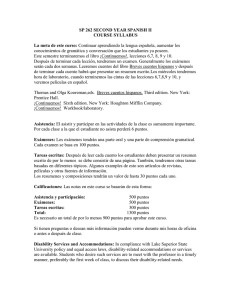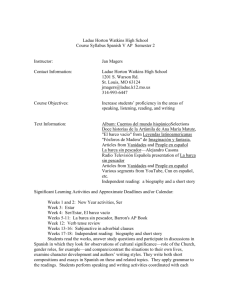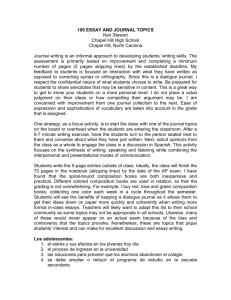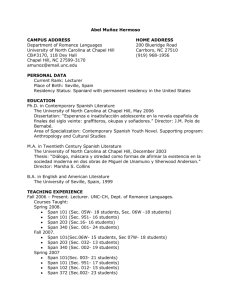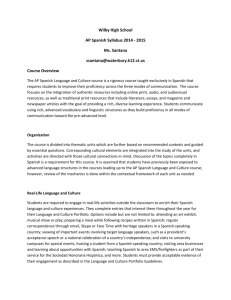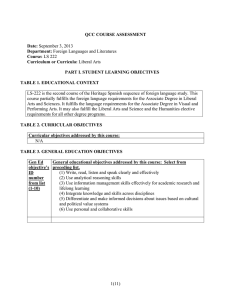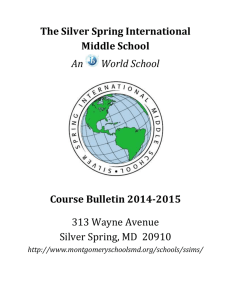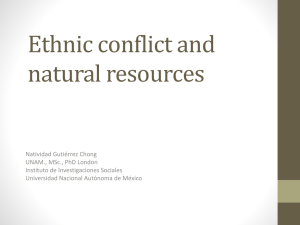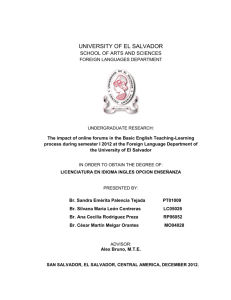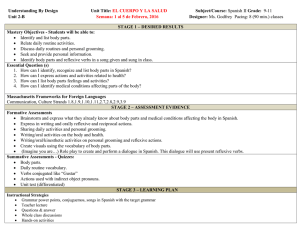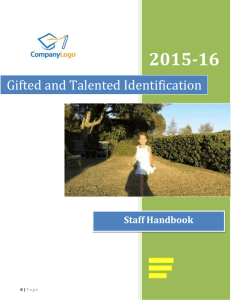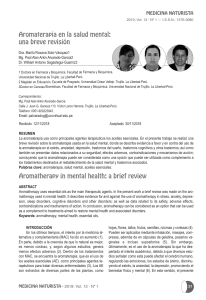AP Spanish Language and Culture 2013-14
advertisement
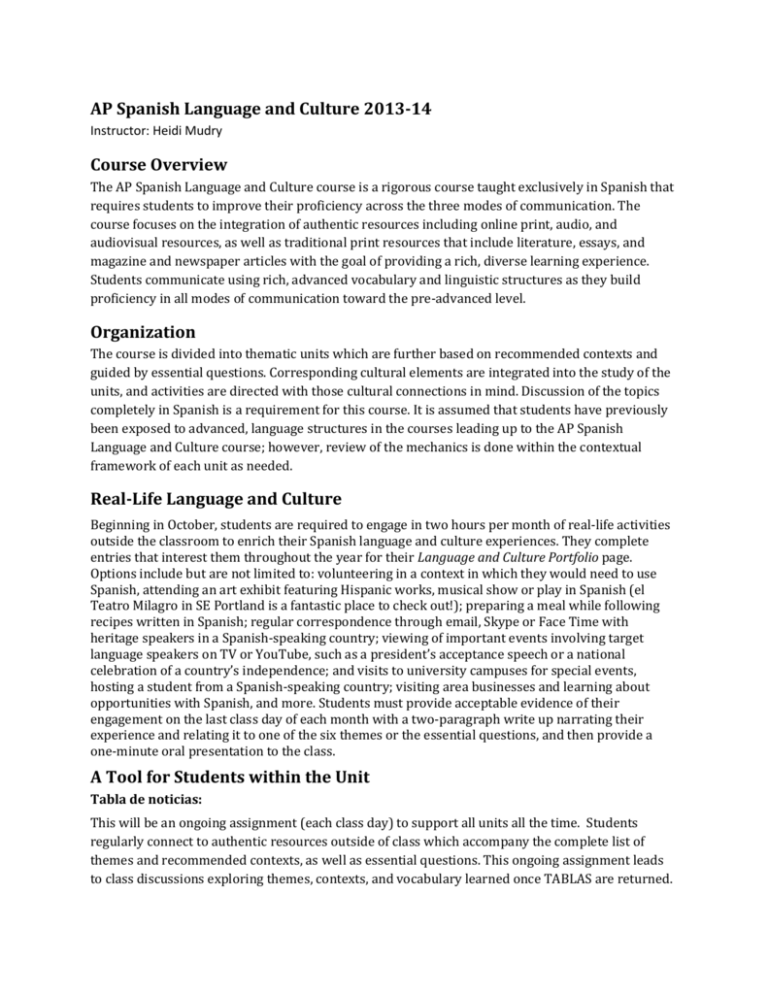
AP Spanish Language and Culture 2013-14 Instructor: Heidi Mudry Course Overview The AP Spanish Language and Culture course is a rigorous course taught exclusively in Spanish that requires students to improve their proficiency across the three modes of communication. The course focuses on the integration of authentic resources including online print, audio, and audiovisual resources, as well as traditional print resources that include literature, essays, and magazine and newspaper articles with the goal of providing a rich, diverse learning experience. Students communicate using rich, advanced vocabulary and linguistic structures as they build proficiency in all modes of communication toward the pre-advanced level. Organization The course is divided into thematic units which are further based on recommended contexts and guided by essential questions. Corresponding cultural elements are integrated into the study of the units, and activities are directed with those cultural connections in mind. Discussion of the topics completely in Spanish is a requirement for this course. It is assumed that students have previously been exposed to advanced, language structures in the courses leading up to the AP Spanish Language and Culture course; however, review of the mechanics is done within the contextual framework of each unit as needed. Real-Life Language and Culture Beginning in October, students are required to engage in two hours per month of real-life activities outside the classroom to enrich their Spanish language and culture experiences. They complete entries that interest them throughout the year for their Language and Culture Portfolio page. Options include but are not limited to: volunteering in a context in which they would need to use Spanish, attending an art exhibit featuring Hispanic works, musical show or play in Spanish (el Teatro Milagro in SE Portland is a fantastic place to check out!); preparing a meal while following recipes written in Spanish; regular correspondence through email, Skype or Face Time with heritage speakers in a Spanish-speaking country; viewing of important events involving target language speakers on TV or YouTube, such as a president’s acceptance speech or a national celebration of a country’s independence; and visits to university campuses for special events, hosting a student from a Spanish-speaking country; visiting area businesses and learning about opportunities with Spanish, and more. Students must provide acceptable evidence of their engagement on the last class day of each month with a two-paragraph write up narrating their experience and relating it to one of the six themes or the essential questions, and then provide a one-minute oral presentation to the class. A Tool for Students within the Unit Tabla de noticias: This will be an ongoing assignment (each class day) to support all units all the time. Students regularly connect to authentic resources outside of class which accompany the complete list of themes and recommended contexts, as well as essential questions. This ongoing assignment leads to class discussions exploring themes, contexts, and vocabulary learned once TABLAS are returned. Unit One: El valor de la familia y la comunidad Theme: Families and Communities / Las familias y las Comunidades Contexts Included: Customs and Values / Las tradiciones y los valores Education Communities / Las comunidades educativas Family Structure / La estructura de la familia Global Citizenship / La ciudadanía global Human Geography / La geografía humana Social Networking / Las redes sociales Essential Questions: ¿Cómo se define la familia en distintas sociedades? ¿Cómo contribuyen los individuos al bienestar de las comunidades? ¿Cuáles son las diferencias en los papeles que asumen las comunidades y las familias en las diferentes sociedades del mundo? Example Activities: 1. Using the painting, “La tamalada” by Carmen Lomas Garza, students complete a graphic organizar answering the following questions on their own and then discussing in small groups: a. ¿Cuáles son algunos productos culturales asociados con este cuadro? b. ¿Cuáles son algunas prácticas culturales asociadas con este cuadro? 2. Students read “Las medias rojas” by Emilia Pardo Bazán, and answer comprehension questions. With a partner, think about a short story from their culture that also portrays child abuse and compare the two stories using a Venn diagram. Assessments: 1. Students write a letter to a governor explaining why there should be more laws against violence and abuse. 2. Research a famous Hispanic painter that has depicted a family and present this to the class in a formal oral presentation of two minutes. 3. Persuasive essay, “¿Es la familia la major manera para ayudar a los individuos a mantener el bienestar de las comunidades? Use the following sources: a. Univision: http://sitios.univision.com/generacion-america/nuestrashistorias/video/2013-10-18/generacion-america-maggie-jimenez-la-familia-esprimero?refPath=videos/ b. Graph on p. 30: http://www.eclac.org/publicaciones/DesarrolloSocial/0/LCL2530PE/sps120_LCL2 530.pdf c. Explanation of Brave New World: http://es.wikipedia.org/wiki/Un_mundo_feliz Authentic Resources 1. La Nacion (online newspaper): Las redes sociales cambiaron para siempre a América Latina 2. Listening: www.masvoces.org 3. Cortometraje: La leyenda del espantapájaros: YouTube 4. Song: El espantapájaros por Ricardo Arjona Unit Two: Los efectos de la tecnología Theme: Science and Technology / La ciencia y la tecnología Contexts Included: Access to Technology / El acceso a la tecnología Eff. of Tech. on Self and Society / Los efectos de la tecnología en el individuo y en la sociedad Health Care and Medicine / El cuidado de la salud y la medicina Innovations / Las innovaciones tecnológicas Natural Phenomena / Los fenómenos naturales Science and Ethics / La ciencia y la ética Essential Questions: ¿Qué impacto tiene el desarrollo científico y tecnológico en nuestras vidas? ¿Qué factores han impulsado el desarrollo y la innovación en la ciencia y la tecnología? ¿Qué papel cumple la ética en los avances científicos? Example Activities: 1. Video-clip: “Móviles: una revolución en la salud” and interview students about cell phones regarding how often they use them, how they use them, etc. Make graph of their findings and explain in class. 2. Research stem-cell research with the following sources: www.bionetonline.org/castellano/content/scintro.htm, www.rtve.es/noticias/celulasmadre, and debate on pros and cons using citing the sources. Assessments: 1. Formal presentation with graphs, tables and statistics, students present on a health, educational, emergency, or societal issue or tool that has been improved by technology compared to 25 years ago. 2. Using the information from the presentation, students write an email to the director of a hospital in a Spanish-speaking country asking if the new technology is used in the hospital. The email must include additional questions about the technology. 3. Students read “Rosa”by Ángel Balzarino and write a review based on the story. Authentic Resources: 1. Online newspaper El País: El genio que humanizó la tecnología 2. Texto: Tecnología para mejorar la calidad de la vida de los enfermos crónicos 3. Audio: Radioteca. Comprehension activity about the human genome. Unit Three: ¿Cómo se define la belleza? Theme: Beauty and Aesthetics / La belleza y la estética Contexts Covered: Architecture / La arquitectura Defining Beauty / Definiciones de la belleza Defining Creativity / Definiciones de la creatividad Fashion and Design / La moda y el diseño Language and Literature / El lenguaje y la literatura Essential Questions: ¿Cómo se establecen las percepciones de la belleza y la creatividad? ¿Cómo influyen los ideales de la belleza y la estética en la vida cotidiana? ¿Cómo las artes desafían y reflejan las perspectivas culturales? Example Activities: 1. Students research 10 paintings by Diego Rivera and Salvador Dalí and fill out a Reacciones chart which includes Dato Interesante (12), Mi Reacción, La reacción de mi colega, with a partner. 2. Students read “Dos palabras” by Isabel Allende and answer comprehension questions. Then, they write similarities between this short story and a painting by Diego Rivera. Assessments: 1. Students paint their own representation depicting fantasy or reality, and present information about the artist they are modeling and an explanation of their painting in a formal presentation. Class fills out a critique of presenters. 2. Essay comparing the traditions of one community with the traditions shown in the works of art studied: Compara los productos, prácticas y perspectivas culturales de una tradición de tu comunidad con una tradición en una de las obras de arte que hemos estudiado. Authentic Resources: 1. Texto: Chac Mool por Carlos Fuentes 2. Audio: Un día de estos por García Márquez 3. Arte: La persistencia de la memoria por Dalí/ Sueño de una tarde dominical en la alameda central por Diego Rivera 4. Arquitectura: La Sagrada Familia, Antonio Gaudí Unit Four: ¿Quiénes somos y cómo es nuestra vida? Theme: Contemporary Life / La vida contemporánea Contexts Covered: Education and Careers / La educación y las carreras profesionales Lifestyles / Los estilos de vida Relationships / Las relaciones personales Essential Questions: ¿Cómo definen los individuos y las sociedades su propia calidad de vida? ¿Cómo influyen los productos culturales, las prácticas y las perspectivas de la gente en la vida contemporánea? ¿Cuáles son los desafíos de la vida contemporánea? Example Activities: 1. Compare “Los Sanfermines de Pamplona” www.ver-taal.com with rodeos in the U.S. 2. Interview students in class about what their most precious object is. Graph. 3. After class discussion about important celebrations in the community, students research and compare 10 celebrations in the U.S., Spain, and Latin America Assessments: 1. Essay: ¿Es la vida de un joven adolescente en 2013 la más difícil en la historia del hombre? Resources: a. Article: http//ajoprobo.blogspot.com/2007/09/los-retos-de-los-jvenes.htm b. Graph: http://contacto.med.puc.cl/destacados/suicidios/suicidios.html c. Video: http://www.youtube.com/watch?v=NGw6gW9URDw 2. Interview a Spanish-speaking student from another advanced Spanish class or from another school using Skype to find out what that student’s favorite celebration is and why. Write summary of the interview. Authentic Resources 1. Audio: Más voces, Reportaje sobre el Día de la Hispanidad 2. Internet: www.ver-taal.com Los Sanfermines de Pamplona 3. Info on best careers in Argentina and Mexico: www.informador.com.mx, www.lagaceta.com 4. Video: Carlos Slim Domit Unit Five: Nosotros y nuestro mundo Theme: Global Challenges [CR6a] Contexts Covered: Economic Issues / Los temas económicos Environmental Issues / Los temas del medio ambiente Philosophical Thought and Religion / El pensamiento filosófico y la religión Population and Demographics / La población y la demografía Social Welfare / El bienestar social Social Conscience / La conciencia social Essential Questions: ¿Cuáles son los desafíos sociales, políticos y del medio ambiente que enfrentan las sociedades del mundo? ¿Cuáles son los orígenes de esos desafíos? ¿Cuáles son algunas posibles soluciones a esos desafíos? Example Activities: 1. Jigsaw activity with the following articles followed by a group vote for the best article and a group opinion column about the winning article: a. Un estudio augura catástrofes naturales causadas por el cambio climático b. Respuesta progresista para la crisis global c. Las cadenas de la pobreza 2. Video “Desafíos mundiales”www.youtube.com/watch?v=enCpXcty3Ec and write their opinions answering the question, ¿Cuáles son los desafíos sociales, políticos y del medio ambiente que enfrentan las sociedades del mundo? Assessments: 1. Students research ways that their school could be more Earth-friendly and then write an email to the school board to try to make changes to their school. 2. After researching sites such as UNESCO and Radio Naciones Unidas, students prepare a 2minute formal presentation using Prezi or PowerPoint or Educreations of one global challenge from the perspective of at least one Spanish-speaking country. Answer the following questions: a. ¿Cuáles son los desafíos sociales, políticos y del medio ambiente que enfrentan las sociedades del mundo? b. ¿Cuáles son los orígenes de esos desafíos? c. ¿Cuáles son algunas posibles soluciones a esos desafíos? Authentic Resources: 1. Audio: audiria.com, La crisis económica en España 2. Texto: El colombiano que lucha por salvar los corales, www.bbc.co.uk 3. Internet sites UNESCO, Radio Naciones Unidas: explore themes of global challenges Unit Six: El individuo y su identidad Theme: Personal and Public Identities / Las identidades personales y públicas[CR6d] Contexts Covered: Alienation and Assimilation / La enajenación y la asimilación Heroes and Historical Figures / Los héroes y los personajes históricos National and Ethnic Identities / La identidad nacional y la identidad étnica Personal Beliefs / Las creencias personales Self-Image / La autoestima Essential Questions: ¿Cómo se expresan los distintos aspectos de la identidad en diversas situaciones? ¿Cómo se desarrolla la identidad de una persona a lo largo del tiempo? ¿Cómo influyen la lengua y la cultura en la identidad de la persona? Example of Activities: 1. Using the Univision audiovisual resource, “Famosos inmigrantes sufrieron en carne propia,” http:noticias.univision.com, students write a Venn diagram on the disadvantages and advantages of immigrants in the USA. 2. Students read the poem, “Balada de dos abuelos,” Nicolás Guillén, and make a T-chart with lo que entendí, lo que entendió mi compañero, las preguntas que tengo, filling out the first and last columns first and then the middle and last with partner. Assessments: 1. Students give a 2-minute presentation comparing the poem “Balada de dos abuelos”with a ballad/song from another country/community. 2. Persuasive essay on “Son importantes las contribuciones de los latinos/hispanos en los EE.UU?”using the following sources: a. News article “100 Latinos Miami” www.elnuevoherald.com b. www.markettolatinos.com/demographic-economic-charts.html 3. Students interview and record a conversation with a Spanish-seaking “hero” that they consider a hero for any particular reason and then write why they selected this person as a hero. Authentic Resources: 1. Bbcmundo.com, EE.UU y la educación: la batalla de una familia de inmigrantes 2. Online newspaper, www.elnuevoherald.com 100 Latinos Miami 3. Película: La misma luna Grades in AP Spanish are based upon the following: Formative Assessments: In-class activities, blog entries, quizzes, “El español en mi vida,” Tablas de noticias AP Practice Assessments: Interpersonal Speaking, Interpersonal Writing, Interpretive Reading, Interpretive Listening, Presentational Speaking, Presentational Writing The grade will be a running total of assessed activities Examen AP: martes, 6/mayo, 2014 7:30am HRVHS Computer Lab. It is not a requirement of the course that each student takes the exam, but it is highly recommended. We will discuss this more as the date approaches. Text & Published Resources Frisancho, Jorge, AP Spanish Language and Culture Exam Preparation, Vista Higher Learning, 2014. Dragget, Parthena, Temas AP Spanish Language and Culture, Vista Higher Learning, 2014. Online Resources (sample, not limited to the following): www.elmundo.es www.ver-taal.com www.laits.utexas.edu/spe/ www.un.org/spanish/News/ www.cronica.com.mx/ www.elmundo.com www.elpais.com www.reforma.com/ www.latercera.com www.masvoces.org www.eluniverso.com http://audiria.com http://clear.msu.edu/teaching/online/ria/ www.rae.es www.bbcmundo.com http://cnnespanol.cnn.com/ www.nuevoshorizontes.org/
